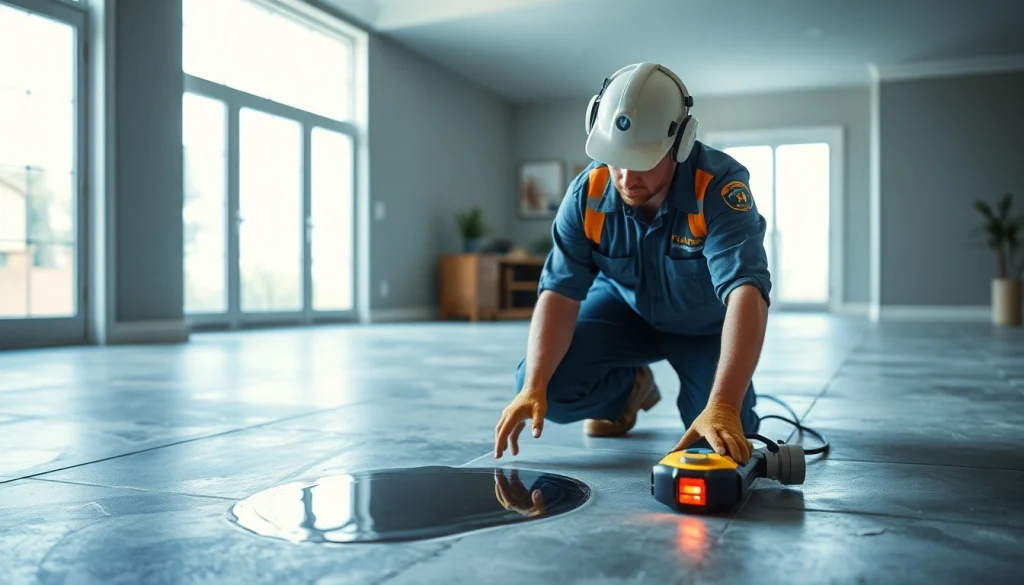Essential Steps to Identify a Leak in Concrete Floor: Professional Guide for 2025

Understanding Leaks in Concrete Floors
A leak in a concrete floor, often referred to as a slab leak, can have severe implications for your home’s integrity and your finances. As these leaks typically occur beneath a home’s concrete slab foundation, they can go unnoticed until significant damage has occurred. In this article, we will explore the causes, signs, and critical aspects of leak detection and repair, providing you with the knowledge needed to safeguard your property. When exploring options, leak in concrete floor detection is crucial for effective maintenance.
What Causes a Leak in Concrete Floors?
Several factors can lead to a leak in concrete floors. Some common causes include:
- Corroded pipes: Over time, pipes, particularly copper ones, can corrode due to various factors like soil chemistry, leading to leaks.
- Soil shifts: Changes in soil composition or settling can create pressure on pipes, causing them to crack or break.
- Poor installation: If plumbing systems are improperly installed, they may be susceptible to leaks.
- Temperature changes: Extreme weather fluctuations can cause pipes to expand and contract, leading to potential breaks.
Signs of a Leak in Concrete Floors
Being aware of the signs of a slab leak can help mitigate damage and repair costs. Key indicators include:
- Unexplained moisture or damp patches: Look for wet spots on the floor or walls, which may indicate a hidden leak.
- Increased water bills: A sudden spike in your water bill without a corresponding increase in usage may point to a leak.
- Sound of running water: Hearing water noises when all taps are turned off can suggest a leak.
- Mold or mildew growth: The presence of mold in areas that are not typically humid can indicate moisture issues.
Importance of Early Detection
Detecting a leak in its early stages is crucial to prevent extensive damage that can lead to costly repairs. Water damage can weaken the home’s structural integrity and promote mold growth, which poses health risks. Early detection allows homeowners to address issues before they escalate, ultimately saving time, money, and preserving property value.
Investigation Techniques for Leaks under Concrete
When it comes to finding leaks beneath concrete floors, employing advanced investigation techniques is essential to ensure minimal disruption and accurate detection. Homeowners should consider methods like:
Non-Invasive Detection Methods
Non-invasive methods allow leak detection without damaging the concrete slab. Techniques include:
- Pressure testing: Monitoring pressure changes in plumbing systems can help isolate the leak’s location.
- Moisture mapping: This technique helps identify areas with abnormal moisture levels that may indicate underlying leaks.
Use of Thermal Imaging in Leak Detection
Thermal imaging cameras can detect temperature variations associated with leaking water. By scanning the concrete for cold or warm spots, technicians can efficiently locate leaks without invasive procedures.
Acoustic Listening Devices Explained
These devices amplify the sound of escaping water or gas, allowing technicians to pinpoint leaks even when they are hidden underground or behind walls. Acoustic listening devices are particularly useful in detecting subtle leaks that may not be immediately apparent.
Repairing a Leak in Concrete Floors
Once a leak is detected, timely and effective repair is vital to maintain the integrity of your home. Various repair techniques are employed based on the leak’s severity and location.
Common Repair Techniques Overview
Some common methods for repairing slab leaks include:
- Slab Jacking: This method involves injecting material beneath the slab to lift and stabilize it.
- Pipe rerouting: Sometimes, it is more effective to reroute plumbing instead of repairing existing pipes.
- Breaking through the slab: In certain situations, technicians may need to excavate the concrete to access and repair the damaged pipe.
Cost Considerations: What to Expect in 2025
The costs of repairing a leak in a concrete floor can vary significantly based on the location and severity of the damage. Homeowners can expect to budget between $500 and $2,500 or more for slab leak repairs in 2025, depending on the chosen method and labor involved. It’s essential to obtain multiple quotes and ensure you’re working with qualified technicians.
When to Call a Professional Leak Detection Service
Engaging a professional leak detection service is advisable when you suspect a leak but cannot locate the source. Qualified technicians possess advanced tools and techniques that ensure accurate detection and repair, minimizing potential damage to your property.
Preventative Measures and Maintenance
Implementing preventative measures can save homeowners time and money in the long run. Here are some best practices:
Best Practices to Avoid Future Leaks
- Regular inspections: Schedule routine plumbing inspections to catch potential issues early.
- Maintain proper drainage: Ensure that water drains away from your home’s foundation to reduce pressure on plumbing.
- Monitor for signs: Be proactive in observing changes in your water bill or household water pressure.
Regular Maintenance Checks for Homeowners
Regular maintenance is key to preventing leaks. Homeowners should periodically check for visible pipe wear, monitor humidity levels in basements, and ensure that all appliances are functioning correctly.
Investing in Quality Materials for Plumbing
Opt for high-quality materials when installing or replacing plumbing systems. While this may come at a higher initial cost, it can yield significant savings by reducing the likelihood of future leaks and associated repairs.
Future Trends in Leak Detection Technologies
As technology evolves, so does the potential for more effective leak detection methods. Emerging trends to watch include:
Emerging Technologies for Homeowners in 2025
Innovations in leak detection technology are being developed to enhance accuracy and efficiency. Homeowners can expect the advent of more sophisticated sensors, which can continuously monitor plumbing systems and alert homeowners to potential leaks in real time.
Smart Home Integration in Leak Detection
The integration of smart home systems with leak detection technology is on the rise. Smart leak detectors can send alerts directly to your smartphone, allowing for faster response times.
The Role of AI in Leak Prevention and Detection
Artificial intelligence will play a crucial role in predictive maintenance, helping homeowners anticipate when leaks are likely to occur based on data trends. This proactive approach can lead to significant cost savings and less environmental impact over time.



